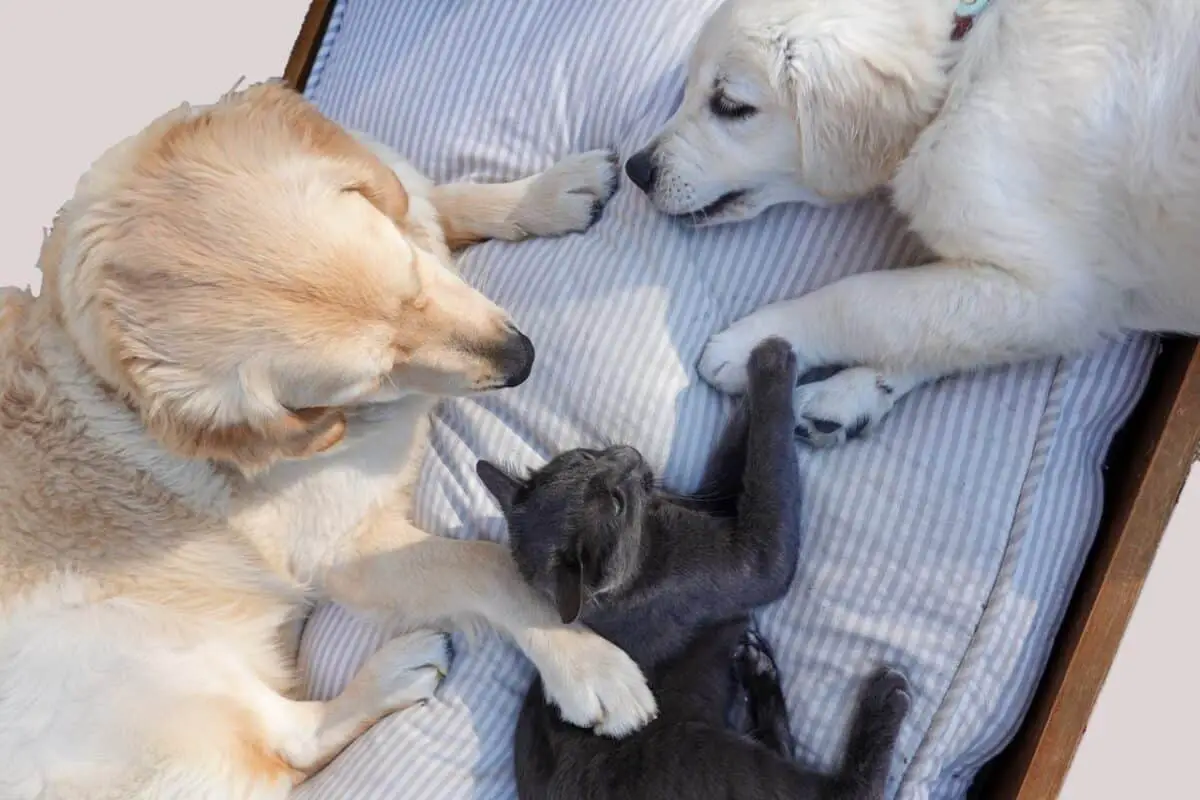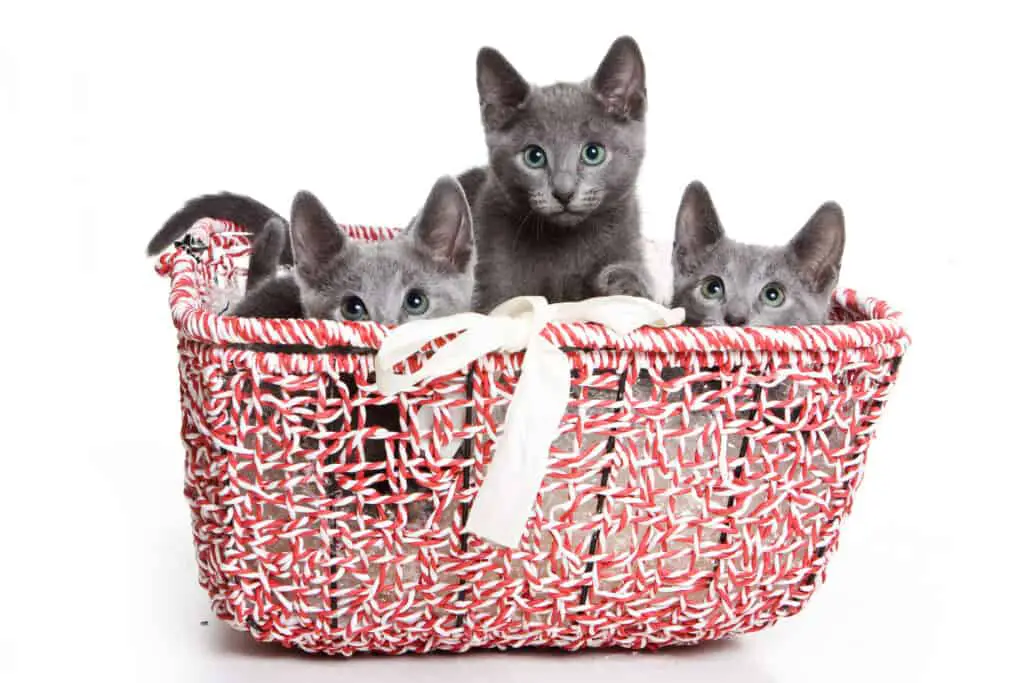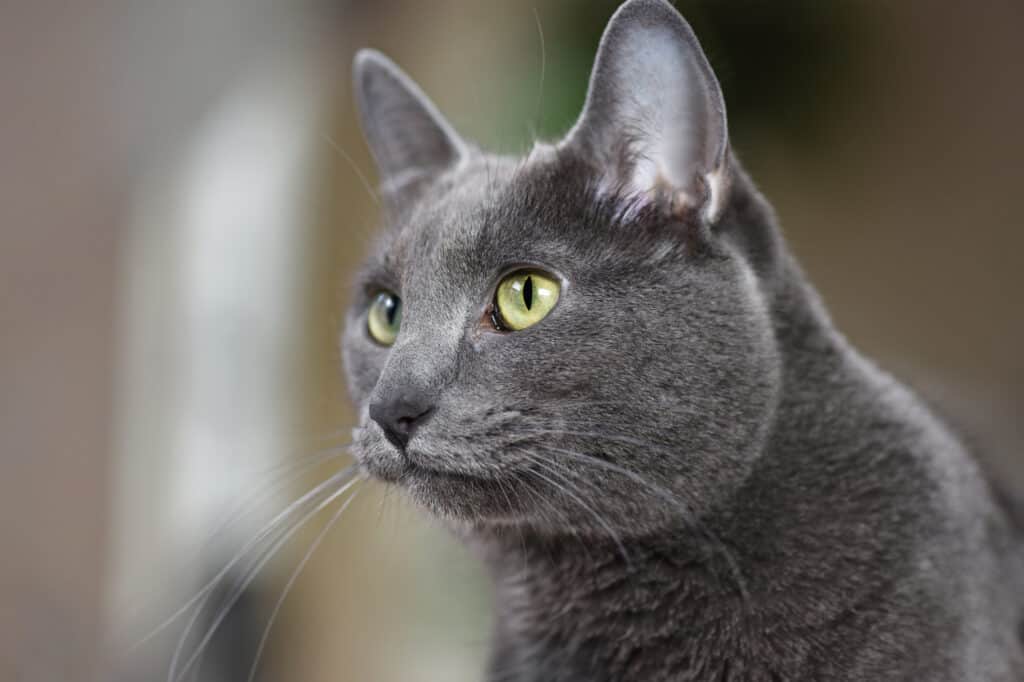Whether you want to add another cat or dog to your home or you’re looking to bring a Russian Blue Cat to a pet-friendly home, you need to understand how well they do with other animals.
Russian Blues are known for their laid-back and easy going character however, they are also known to dislike change and are not fond of surprises and strangers. So, introducing another pet into ‘their’ home requires consideration and planning.
Keep reading as we explore if Russian Blue cats get along well with other pets and what you should consider with each type of animal.
We’ll also explain the best method for making introductions to prevent animosity and how you can improve your cat’s social skills.
Do Russian Blue Cats Go Well With Other Cats?
Russian Blue cats usually go well with other cats as long as the personality of both cats matches. Russian Blues have a soft temperament and like their privacy. Having them live together with another cat with a similar character usually works out well.
Russian Blue Cats get along with other cats, especially other Russian Blues.
You should avoid aggressive, hyperactive, or territorial cats, as they will likely walk all over your Russian Blue Cat.
Most do best with another cat that shares their affection and sweet-tempered approach to life and someone who they can explore the home with.
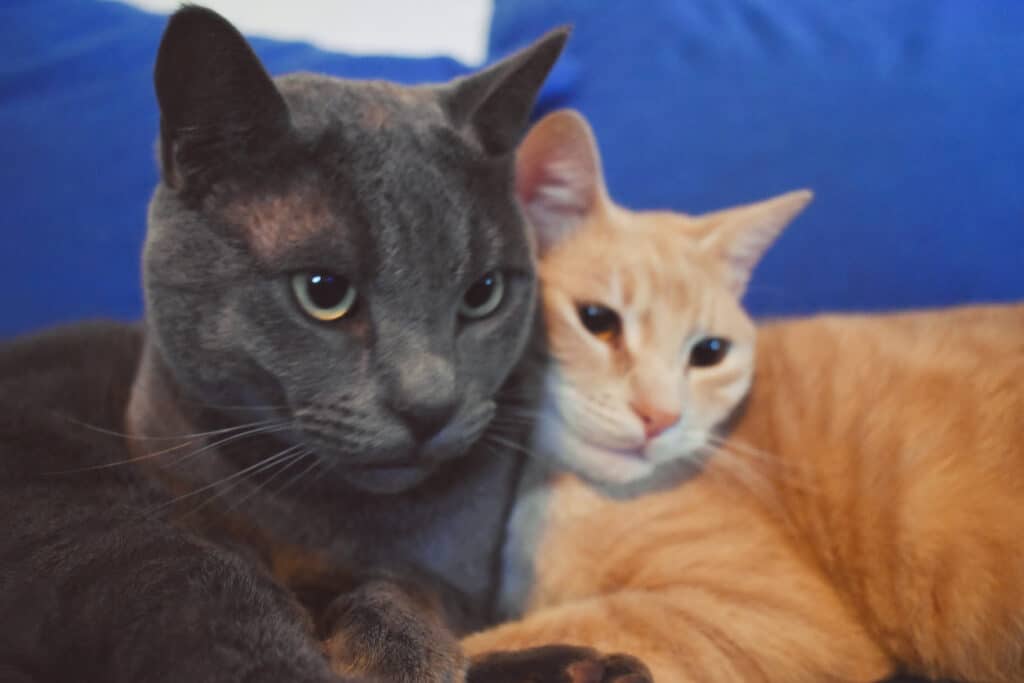
Remember that Russian Blue Cats do not need a feline companion to be happy, unlike Siamese cats. They are usually better off alone than in a forced relationship with another cat.
Do Russian Blue Cats Go Well With Dogs?
Although your Russian Blue might be skittish at first, they will get along with most dogs when introduced in the right way. However, certainly not with all dogs. It’s important to avoid dogs with a high prey drive, cattle dogs, and terriers.
A Russian Blue Cat is likely to get along well with a dog that respects cats, although they may be skittish at first.
It’s best to avoid dogs that haven’t done well with cats in the past or dogs that don’t respect boundaries.
Your Russian Blue Cat may be more aggressive than normal in establishing boundaries with a dog, but this shouldn’t be allowed to the point of pain for either party.
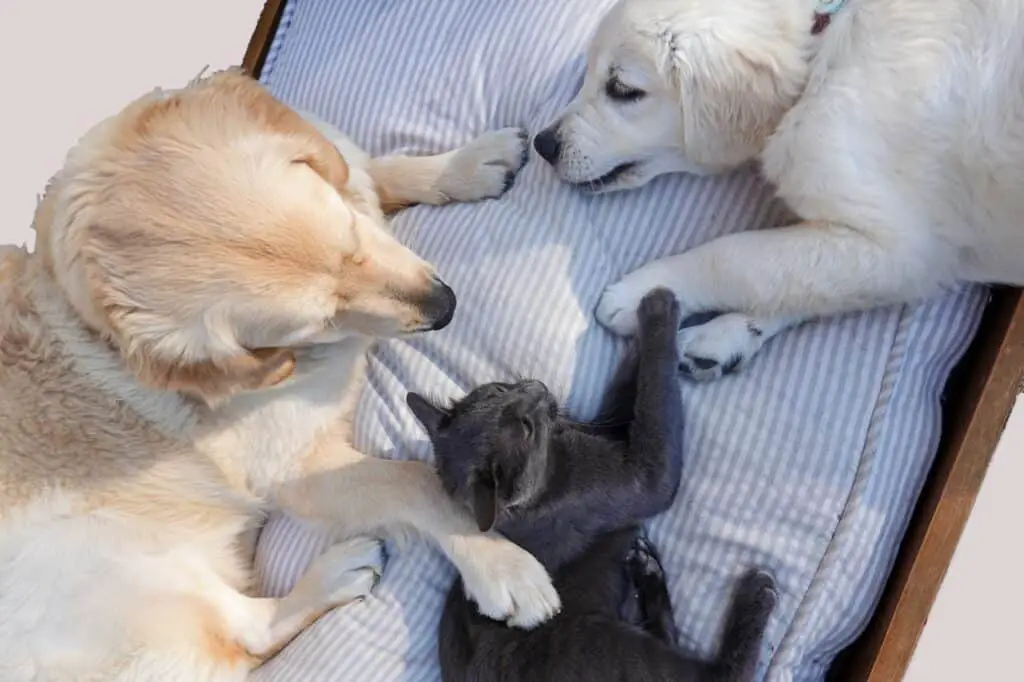
Cats in mixed-species households do best when they have their own spaces to retreat to, including climbing spaces and rooms that deny canine access. This is especially important for Russian Blues because they value their privacy and a place to retreat.
How to Introduce Russian Blue Cats to Other Animals
When making introductions with a new family member, focus on:
- Ensuring the health of each animal
- Introducing by scent first
- Working with barriers
- Decreasing proximity
- Moving to face-to-face interactions
- Monitoring the relationship
There is no specific timeline to follow, so work with what seems right for both animals.
Ensure Health First
Whether you’re introducing a cat or a dog, you need to ensure all the animals involved are up to date on their health screenings.
Part of this ensures that your Russian Blue Cat is not exposed to unnecessary parasites or illnesses. Your cat can get sick even with vaccines, and you want to ensure both animals are as comfortable as possible when meeting.
Making sure both animals are healthy also helps with the integration process because when both animals are comfortable in their body, they’re less likely to be aggressive.
Introduce Scent First
You can give the animals a head start by introducing the other’s scent before they even reach the new home.
This can be as simple as rubbing a blanket on both animals so their scent can exist in the other’s space. This can be done before you bring the other animal home and helps the introduction, later on, be a little easier.
Introducing scent before bodies allows for a smoother transition and reduces the stress of adding another pet into the mix.
Start With Barriers
When you bring the new cat or dog into your home, start your introduction using barriers. There are a few levels to graduate in this process.
Execution of this depends on how much room you have in your home because it’s best to keep both animals in separate spaces for the first couple of days.
It’s enough that each animal knows that the other one is there, but they are unable to meet just yet because of the barriers.
The barriers let the cat get used to the other animal’s scent and presence without forcing their existence on them.
Ideally, there are three separate stages to this.
Stage 1 – Closed Barriers
In this stage, both animals are not allowed to see each other. Keep them in separate rooms or in separate areas of your home.
Keep the newcomer in a smaller room while the resident animal is free to roam the rest of the house. They will become aware of each other’s presence soon enough, and this is another great opportunity for them to take in each other’s scents.
Stage 2 – Transparent Barriers
After a few days, let both animals see each other for the first time while they are not yet allowed to have physical contact.
This can be achieved by still keeping them in separate parts of the house or separate rooms but with the opportunity to look at each other through a window or other transparent partition.
When this goes well, your pets are usually ready to move on to the next stage after a day or two.
Stage 3 – Gated Barriers
This is the final step in the introduction process and will allow scent and visual contact as well as some physical contact.
Ideal for this is a toddler gate such as this one.
Make sure that the gate is sturdy and high enough for the pets not to jump over, at this stage, we still want them to each have separate spaces.

Decrease Proximity
During phase 3, try putting each animal’s food and water dishes close to the barrier and gradually move the two closer as they get more familiar with each other.
Don’t be afraid to take this part slowly or move back if you notice too much agitation or excitement from either animal.
Decreasing the proximity of their living spaces by graduating to a new barrier or moving these items close together helps them understand they need to be comfortable sharing a new space, but it can backfire if you try to force them to get along.
Face-to-Face Introductions
When you’re ready to move on to a face-to-face introduction, you should ensure that:
- Both animals can exit the situation if needed and have a place to retreat
- The more fearful animal has more control over the speed of introduction
- You can interject quickly if needed
When introducing two cats, it may be best to have the more social or less territorial cat in a crate to start. This allows the other cat to pace the introduction as they see fit without worrying about staking their claim or establishing authority.
When introducing a dog to your Russian Blue Cat, start with the dog on a leash. Make sure you have complete control over the animal and let your cat set the pace for the introduction.
Take it slow
Remember that your animals may need more than one monitored face-to-face session before becoming best friends, but it’s important to move at their pace to limit any negative associations.
When you feel that more supervised sessions are needed, you can do this while moving in and out of stage 3 of the introduction process, giving each animal their own space outside of supervised contact.
Monitoring Relationships
Keep an eye out for signs of aggression on either side. This looks different between cats and dogs, but there are a few generic signs to watch out for.
These include:
- Whining or growling
- Hissing
- Stiff stances
- Tip-toeing around each other
- Bared teeth
- Attempted biting
- Slow tail movement
Well-adjusted animals should either leave each other alone or regard each other with affection. Address any sign of actual (not play) fighting immediately.
How to Improve Russian Blue Cat Relationships with Other Animals
If you want to increase your Russian Blue Cat’s chances of socializing with other animals, it’s important to work on this early on.
Ensure you provide plenty of safe space spots in your home that your cat can retreat to, and keep both animals up to date on their health visits. This prevents the relationship from turning sour due to forced interaction, sudden pain, or behavioral issues.
Your Russian Blue Cat will likely adapt to whatever situation you put them in, but it’s always important to let them set the pace while respecting their social cues.
Don’t hesitate to interfere if a relationship turns sour, and make sure you pay attention to both animals for signs of fear or aggression.
Our Final Thoughts
Although Russian Blue cats are perfectly content by themselves, they will adjust to other animals in their home. It’s usually not an easy or fast process, and you need patience and planning to introduce a new pet to your Russian Blue successfully.
The introduction process will work best with younger Russian Blues because their young age makes them more acceptable and interested in other animals. Older Blues will probably have a much harder time adjusting to a new housemate.
As with humans, some introductions are more successful than others, and some animals may not like each other. This can cause stress which leads to both mental and physical issues.
If both animals don’t get along after careful introduction, look for alternatives such as having the newcomer adopted by another loving family.
Do You Enjoy Reading About Cats?
Then you will enjoy our other content, have a look at these popular articles on our website.
-
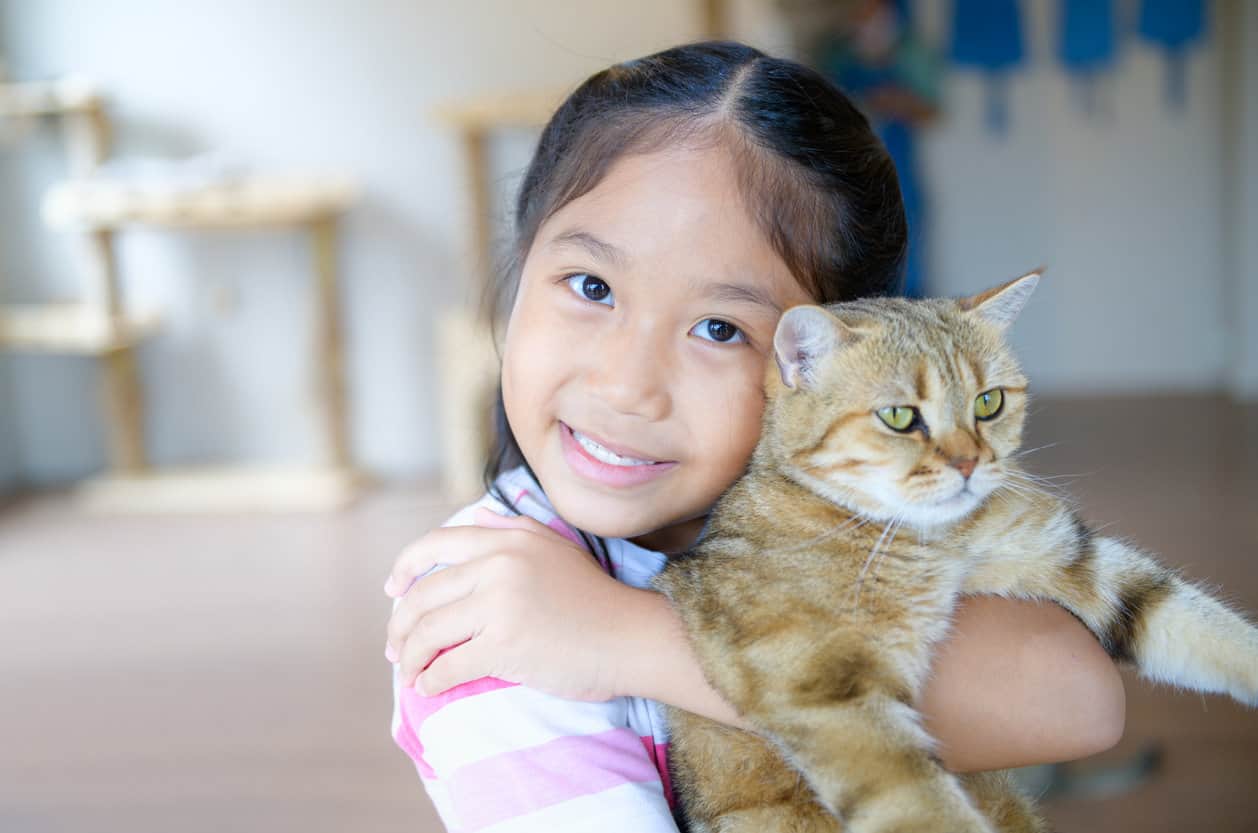
10 Ways to Make Your Cat Live Longer
The oldest cat to ever live passed away at the old age of 38. On average, household cats live between […]
-

12 Reasons Why Siamese Cats Cry at Night
Siamese cats are a popular breed of cats that many people choose to have as pets. Perhaps you have heard […]
-
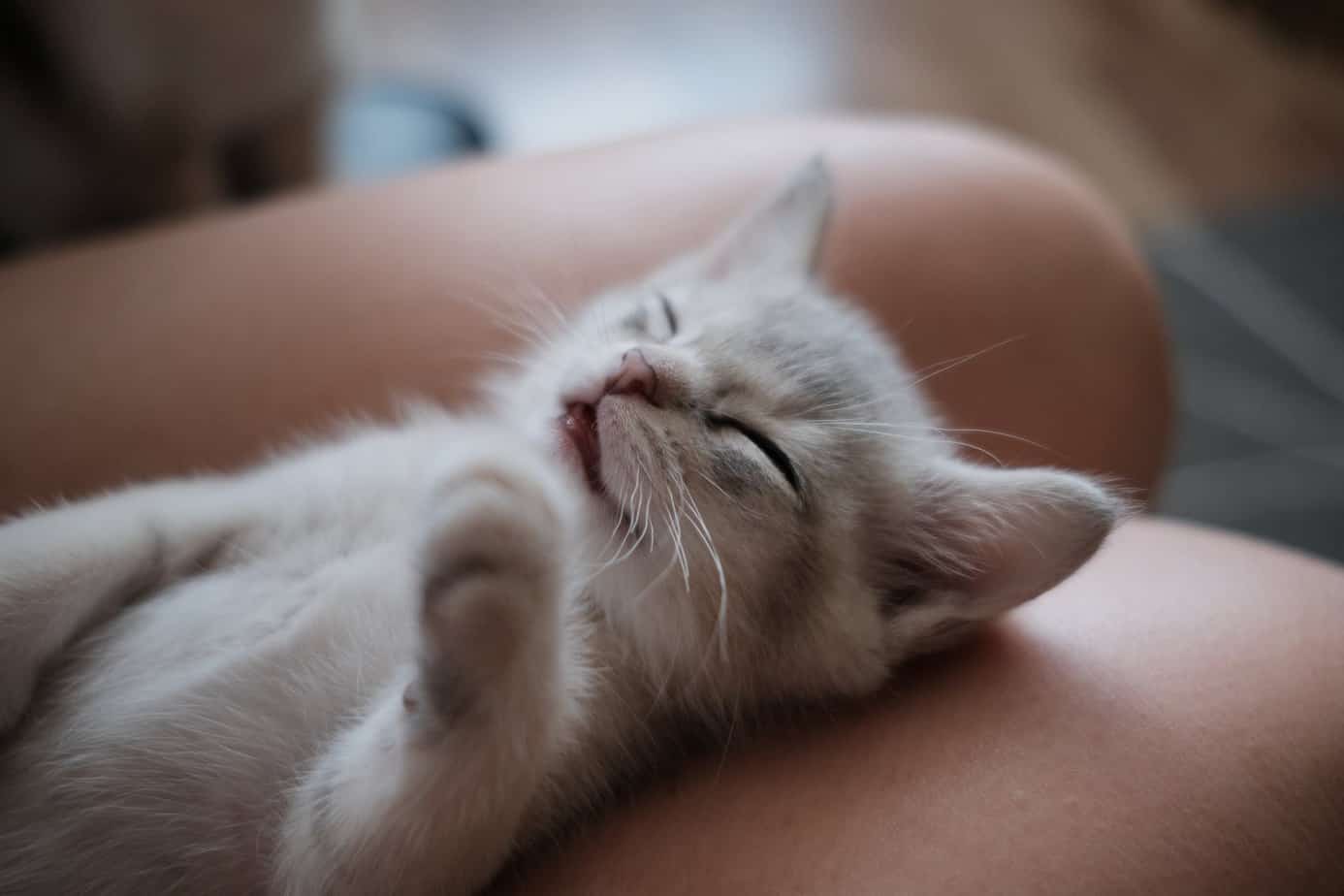
15 Incredible Ways That Cats Show Affection For Humans
Wondering how cats show their affection for humans? We have listed several incredible ways that cats are trying to show their love for us.

